MATLAB Applications in College Assignments: Exploring Channel Coding and Decoding in Communication Systems

It has never been more important to have reliable and effective data transmission in the quickly changing world of communication systems. The integrity of transmitted data is crucially ensured by channel coding and decoding techniques, especially when there is noise, interference, or another channel impairment. Channel coding offers a strong mechanism to identify and fix errors that may happen during transmission by adding redundancy to the original data stream. On the other hand, decoding entails retrieving the original data at the other end, effectively returning the data to its original state. Understanding the fundamentals of channel coding and decoding is crucial for engineering students as communication technologies advance. If you're struggling with understanding these concepts or need assistance to do your communication system assignment, MATLAB emerges as an invaluable tool. it provides a variety of functionalities that let students investigate different coding schemes and their real-world applications in communication systems, MATLAB emerges as an invaluable tool for both learning and applying these concepts.
The foundation of seamless connectivity in the dynamic world of communication systems is efficient data transmission. Techniques for error control coding, provided by a Matlab Assignment Expert, are used to address this problem. The complementary process of decoding serves as the data's recovery mechanism, making sure that the original information is precisely retrieved at the other end. Engineering students must understand these fundamental ideas of channel coding and decoding because they serve as the cornerstone for comprehending and designing communication systems that perform at their best. In this situation, MATLAB demonstrates its value as an essential tool for students' college assignments, providing a wide range of potent tools and functionalities that make it easier to practically explore and apply different channel coding techniques. Students can learn important insights into how these coding systems function in practical situations through MATLAB applications, and they can arm themselves with crucial skills for dealing with communication difficulties in their future careers.

Introduction to Channel Coding and Decoding
Reliable communication and effective data transmission are key components in the world of communication systems. To achieve error-free data transmission over noisy channels, channel coding, and decoding are essential. Redundancy is added to the original data through channel coding in order to shield it from transmission errors. On the other hand, decoding is the process of restoring the original data from the data that has been received, which may have been corrupted.
A crucial communication technique, channel coding is used in a variety of communication systems, including wireless, satellite, optical, and digital television. The transmitted signals in these systems are frequently subject to different kinds of noise and interference, which can lead to data corruption. By identifying and fixing errors in the received data, channel coding techniques allow us to increase the communication system's dependability.
According to their noise properties, channels are categorized in communication theory. Binary erasure channel (BEC), additive white Gaussian noise (AWGN), binary symmetric channel (BSC), and other terms are all used to describe channels. To accommodate particular channel characteristics and enhance the performance of the communication system, various channel coding techniques have been developed.
Basics of Channel Coding
Error detection codes and error correction codes are two broad categories for channel coding techniques.
Error Detection and Correction
To determine whether errors have occurred during data transmission, error detection codes are comparatively straightforward coding techniques. These codes give the data more redundancy so that the receiver can check to see if the data it has received is error-free. The receiver may ask for a retransmission of the data if an error is found in order to guarantee its accuracy.
The parity check code is one of the most well-known types of error detection codes. To make the overall number of ones (or zeros) in the codeword even (or odd), an additional bit is added to the data in a single parity check code. An error is identified during transmission if the quantity of bits received with the opposite parity is odd. Parity check codes are straightforward, but they can only find errors—not fix them.
Types of Error Correction Codes
Forward error correction (FEC) codes, also referred to as error correction codes, are more complex coding methods that can both detect and correct errors. These codes add redundant information to the data stream so that the receiver can spot and fix mistakes without having to retransmit them.
The Hamming code is one of the earliest and most popular error correction codes. Block codes called Hamming codes add parity bits to data based on where the 1s are located in the binary representation of the bit position. The receiver can detect and fix single-bit errors in the received data thanks to this construction. Hamming codes are suitable for introductory studies on channel coding because they are easy to comprehend and apply.
Convolutional Codes
Another type of error-correction code frequently utilized in communication systems is convolutional code. Convolutional codes, in contrast to block codes, encrypt data in a continuous stream, making them particularly advantageous for memory-based channels where the current output is dependent on the inputs from the past.
Using a sliding window of input bits and a predetermined set of transition rules, convolutional codes generate output bits during the encoding process. Due to the requirement for sequential processing and memory, decoding convolutional codes is more difficult than decoding block codes. The Viterbi algorithm, which finds the most likely route through the code trellis using dynamic programming, is a well-known decoding algorithm for convolutional codes.
MATLAB Application: Implementing Hamming Codes
Let's use Hamming codes as an illustration of channel coding in MATLAB. Hamming codes are block codes that increase the original data's parity bits in order to detect and correct errors.
One of the simplest Hamming codes is the (7,4) code, which converts 4 data bits into a 7-bit codeword by adding 3 parity bits. In order to support single-bit error correction and double-bit error detection, the parity bits are positioned at specific locations in the codeword.
% Hamming encoder and decoder functions
function codeword = hamming_encode(msg)
% Generator matrix for (7,4) Hamming code
G = [1 1 0 1; 1 0 1 1; 1 0 0 0; 0 1 1 1];
codeword = mod(msg * G, 2);
end
function decoded_msg = hamming_decode(codeword)
% Parity-check matrix for (7,4) Hamming code
H = [eye(3), transpose(G(:, 1:3))];
syndrome = mod(codeword * H', 2);
% Error correction
if any(syndrome)
error_pos = bi2de(fliplr(syndrome)) + 1;
codeword(error_pos) = ~codeword(error_pos);
end
decoded_msg = codeword(1:4);
end
% Example usage
msg = [0 1 1 0]; % 4-bit message
codeword = hamming_encode(msg);
disp("Encoded Codeword:");
disp(codeword);
decoded_msg = hamming_decode(codeword);
disp("Decoded Message:");
disp(decoded_msg);
To implement the encoding and decoding procedures of a (7,4) Hamming code, we define two functions in this MATLAB code: hamming_encode and hamming_decode. A 4-bit message is passed to the hamming_encode function, which outputs the corresponding 7-bit codeword with additional parity bits. The received codeword is passed to the hamming_decode function, which uses the parity-check matrix to perform error detection and correction before returning the decoded 4-bit message.
This MATLAB Hamming code implementation can be used to investigate block codes' capacity for error correction and to see how single-bit errors are handled during data transmission.
Advanced Channel Coding Techniques
More sophisticated channel coding methods, like Turbo codes and LDPC (Low-Density Parity-Check) codes, have emerged to achieve even better performance. Block codes and convolutional codes already offer effective error correction capabilities.
Turbo Codes
Claude Berrou introduced turbo codes in 1993, which are a significant improvement over previous error-correction coding methods. They are potent forward error correction codes with performance close to the Shannon limit. When creating a turbo code, two or more convolutional codes are joined together with an interleaved. To produce a more reliable coding structure, the interleaved rearranges the input data.
Turbo codes use an iterative decoding technique where the individual decoders exchange data over the course of several decoding passes. Turbo codes are extremely effective at correcting errors thanks to their iterative nature, which enables them to get close to the theoretical channel capacity.
LDPC Codes
Another class of potent error correction codes is the LDPC code family, which Robert Gallager first proposed in the 1960s. When decoded using iterative algorithms, LDPC codes have the remarkable property of achieving performance that is capacity-approaching.
Because LDPC codes are represented by sparse parity-check matrices, effective decoding algorithms are possible. Passing messages between variable nodes (representing data bits) and check nodes (representing parity constraints) is a necessary step in the iterative decoding of LDPC codes. Until the messages converge and the decoded data is obtained, the process is repeated.
Due to their impressive performance, particularly in scenarios involving high data rates and difficult channel conditions, LDPC codes have found extensive use in contemporary communication systems.
MATLAB Application: Implementing Turbo Codes
Since the decoding process for Turbo codes is iterative, implementing them from scratch can be difficult. However, the Communications System Toolbox in MATLAB has useful functions for working with Turbo codes.
How to use Turbo encoding and decoding is demonstrated by the following snippet of MATLAB code:
% Turbo encoder and decoder
turboEncoder = comm.TurboEncoder;
turboDecoder = comm.TurboDecoder;
% Input data
msg = [0 1 1 0 1 0 1 1]; % 8-bit message
% Turbo encoding
encodedData = step(turboEncoder, msg');
% Introducing simulated errors
receivedData = encodedData;
receivedData(3) = ~receivedData(3); % Flip one bit
% Turbo decoding
decodedData = step(turboDecoder, receivedData);
disp("Original Message:");
disp(msg);
disp("Decoded Message:");
disp(decodedData');
The Communications System Toolbox's built-in functions comm.TurboEncoder and comm.TurboDecoder is used in this MATLAB code to implement Turbo encoding and decoding. The Turbo encoder is used to encrypt an 8-bit message that is the input message. By flipping one bit in the encoded data (receivedData), simulated errors are brought about. The Turbo decoder then makes an effort to fix the problems and get the original message back.
This illustration shows the potent error correction abilities of Turbo codes, which can greatly enhance the performance of communication systems, especially in conditions with high noise and interference levels.
Conclusion
In order to ensure reliable data transmission in modern communication systems, channel coding and decoding techniques are crucial components. Channel coding offers a way to shield transmitted data from errors and noise, and decoding allows the receiver's end to recover the original data.
A flexible platform is provided by MATLAB to investigate and use different channel coding methods. The extensive functionalities of MATLAB make it easier to comprehend and simulate these coding schemes, which range from basic error detection codes like parity check codes to complex error correction codes like Turbo codes and LDPC codes.
MATLAB is a useful resource for college assignments on communication systems and channel coding. Students can experiment with different coding techniques, evaluate their performance under various channel conditions, and gain a deeper understanding of the concepts underlying channel coding and decoding by utilizing MATLAB's capabilities. Channel coding remains a crucial component of communication systems even as technology develops, making MATLAB an essential tool for aspiring engineers and scientists in this field.